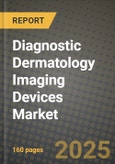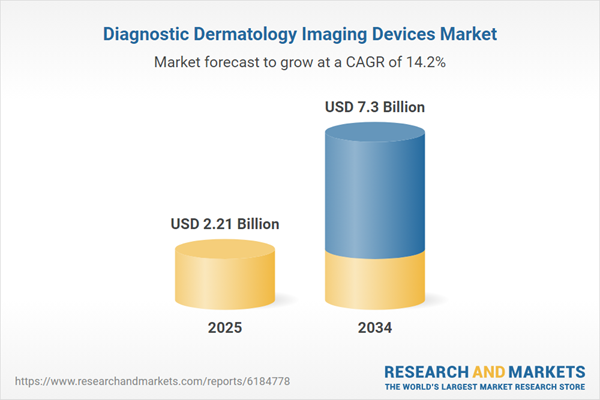Diagnostic Dermatology Imaging Devices Market
The diagnostic dermatology imaging devices market covers hardware and software systems used to evaluate skin conditions, diseases, and lesions through non‑invasive imaging technologies. This includes dermoscopy systems, digital optical microscopes, high‑resolution photography and videography devices, confocal microscopy, optical coherence tomography (OCT), multispectral/hyper‑spectral imaging, and AI‑enabled image‑analysis platforms. Key applications span dermatology clinics (mole/lesion screening, skin‑cancer diagnosis, acne and rosacea monitoring), teledermatology (remote image capture and analysis), cosmetic and aesthetic dermatology (monitoring of treatment outcomes), and research/clinical‑trials in skin oncology and dermatopathology. Emerging trends include integration of AI and machine‑learning algorithms for lesion classification and risk‑stratification, smartphone‑based dermoscopy accessories, portable imaging devices for remote care, cloud‑based image‑analytics platforms, and devices combining imaging with real‑time diagnosis or triage. Growth is propelled by rising incidence of skin cancers and other dermatologic conditions worldwide, increasing demand for non‑invasive diagnostic tools, expansion of telehealth and remote dermatology services, and growth of aesthetic dermatology and cosmetic procedures. On the competitive front, device manufacturers, software/image‑analytics firms, cloud‑platform providers and teledermatology service platforms are all involved; success hinges on image‑resolution quality, AI‑algorithm performance/validation, regulatory clearance (e.g., for AI assistance), software‑hardware integration, price‑performance and service support. Additional dynamics include reimbursement environment for imaging/teledermatology, physician adoption barriers (workflow integration, trust in AI outcomes), data‑privacy/security concerns, and requirement for interoperability with electronic‑medical‑records (EMR) systems.Diagnostic Dermatology Imaging Devices Market Key Insights
- Skin cancer screening and early diagnosis as major driver
- AI enabled imaging analysis accelerates capability
- Teledermatology and remote care boost adoption
- Non invasive and patient friendly formats are preferred
- Cosmetic/aesthetic dermatology drives complementary demand
- High quality optics and image resolution differentiate devices
- Regulatory and reimbursement complexity impact adoption
- Workflow integration matters
- Cost and access challenges in emerging markets
- Service, training and data security are critical
Diagnostic Dermatology Imaging Devices Market Reginal Analysis
North America
In North America, the diagnostic dermatology imaging devices market is advanced, supported by high incidence of skin cancer, strong teledermatology adoption, and robust reimbursement frameworks for dermatologic imaging/performance-based diagnosis. Clinics and hospitals invest in premium‑optics imaging devices, AI‑enabled analytics, and integration with EMRs. Growth is moderate‑to‑high, particularly in tele‑dermatology and aesthetic clinics. US‑based device‑manufacturers and integrated service providers dominate; service networks and software support are key differentiators.Europe
Europe’s market is driven by strong dermatology infrastructure, demand for early skin‑cancer detection, regulatory focus on device safety/AI‑validation, and growth in aesthetic clinics. Imaging devices are used both in public health screening (high‑risk populations) and private cosmetic segments. Growth is steady; suppliers emphasise CE‑certified devices, multilingual software, compliance with GDPR for cloud‑based image platforms, and value‑added features (tele‑connectivity, patient portals).Asia‑Pacific
Asia‑Pacific offers the fastest growth for diagnostic dermatology imaging devices, driven by rapidly increasing dermatologic disease burden, rising medical‑tourism, growing aesthetic industry, telehealth adoption and improving clinic penetration. Countries such as China, India, Southeast Asia and Australia are expanding imaging device purchases - both premium optics and affordable smartphone or portable alternatives. Suppliers that localise content, pricing and service support are best placed to capture growth.Middle East & Africa
In Middle East & Africa, the market is emerging - with growth linked to expanding private‑healthcare sectors, medical‑tourism hubs, rising skin‑cancer awareness, and teledermatology in remote locations. However, cost constraints, limited dermatologist density and service‑network limitations slow adoption. Portable and connected imaging solutions, as well as partnership models with tele‑derm platforms, offer opportunity.South & Central America
In South & Central America, the diagnostic dermatology imaging devices market is growing with increasing clinic and hospital investment in dermatology and aesthetic treatments, rising telehealth adoption and expanding cosmetic segments. Challenges include cost sensitivity, import‑duty/clearance issues and uneven service networks. Suppliers that partner with local distributors, provide training and offer financing or leasing options gain advantage.Diagnostic Dermatology Imaging Devices Market Segmentation
By Modality
- Advanced Diagnostic Imaging Devices
- Surface Visualization Devices
- Biopsy Devices
- Molecular Diagnostic Devices & Platforms
By Application
- Skin Cancer
- Inflammatory & Autoimmune Skin Diseases
- Infectious Skin Conditions
- Wound & Ulcer Assessment
By End-User
- Hospitals
- Dermatology Clinics/Centers
- Cancer Centers/Oncology Clinics
- Others
Key Market players
Canfield Scientific, FotoFinder Systems, 3Gen (DermLite), Heine Optotechnik, Caliber Imaging & Diagnostics (VivaScope), Miravex, Emage Medical (DermSpectra), MetaOptima (MoleScope), Barco, DermaSensor, Courage+Khazaka, VisioMed Group, BOMTECH, Pixience, Newtone TechnologiesDiagnostic Dermatology Imaging Devices Market Analytics
The report employs rigorous tools, including Porter’s Five Forces, value chain mapping, and scenario-based modelling, to assess supply-demand dynamics. Cross-sector influences from parent, derived, and substitute markets are evaluated to identify risks and opportunities. Trade and pricing analytics provide an up-to-date view of international flows, including leading exporters, importers, and regional price trends.Macroeconomic indicators, policy frameworks such as carbon pricing and energy security strategies, and evolving consumer behaviour are considered in forecasting scenarios. Recent deal flows, partnerships, and technology innovations are incorporated to assess their impact on future market performance.
Diagnostic Dermatology Imaging Devices Market Competitive Intelligence
The competitive landscape is mapped through proprietary frameworks, profiling leading companies with details on business models, product portfolios, financial performance, and strategic initiatives. Key developments such as mergers & acquisitions, technology collaborations, investment inflows, and regional expansions are analyzed for their competitive impact. The report also identifies emerging players and innovative startups contributing to market disruption.Regional insights highlight the most promising investment destinations, regulatory landscapes, and evolving partnerships across energy and industrial corridors.
Countries Covered
- North America - Diagnostic Dermatology Imaging Devices market data and outlook to 2034
- United States
- Canada
- Mexico
- Europe - Diagnostic Dermatology Imaging Devices market data and outlook to 2034
- Germany
- United Kingdom
- France
- Italy
- Spain
- BeNeLux
- Russia
- Sweden
- Asia-Pacific - Diagnostic Dermatology Imaging Devices market data and outlook to 2034
- China
- Japan
- India
- South Korea
- Australia
- Indonesia
- Malaysia
- Vietnam
- Middle East and Africa - Diagnostic Dermatology Imaging Devices market data and outlook to 2034
- Saudi Arabia
- South Africa
- Iran
- UAE
- Egypt
- South and Central America - Diagnostic Dermatology Imaging Devices market data and outlook to 2034
- Brazil
- Argentina
- Chile
- Peru
Research Methodology
This study combines primary inputs from industry experts across the Diagnostic Dermatology Imaging Devices value chain with secondary data from associations, government publications, trade databases, and company disclosures. Proprietary modeling techniques, including data triangulation, statistical correlation, and scenario planning, are applied to deliver reliable market sizing and forecasting.Key Questions Addressed
- What is the current and forecast market size of the Diagnostic Dermatology Imaging Devices industry at global, regional, and country levels?
- Which types, applications, and technologies present the highest growth potential?
- How are supply chains adapting to geopolitical and economic shocks?
- What role do policy frameworks, trade flows, and sustainability targets play in shaping demand?
- Who are the leading players, and how are their strategies evolving in the face of global uncertainty?
- Which regional “hotspots” and customer segments will outpace the market, and what go-to-market and partnership models best support entry and expansion?
- Where are the most investable opportunities - across technology roadmaps, sustainability-linked innovation, and M&A - and what is the best segment to invest over the next 3-5 years?
Your Key Takeaways from the Diagnostic Dermatology Imaging Devices Market Report
- Global Diagnostic Dermatology Imaging Devices market size and growth projections (CAGR), 2024-2034
- Impact of Russia-Ukraine, Israel-Palestine, and Hamas conflicts on Diagnostic Dermatology Imaging Devices trade, costs, and supply chains
- Diagnostic Dermatology Imaging Devices market size, share, and outlook across 5 regions and 27 countries, 2023-2034
- Diagnostic Dermatology Imaging Devices market size, CAGR, and market share of key products, applications, and end-user verticals, 2023-2034
- Short- and long-term Diagnostic Dermatology Imaging Devices market trends, drivers, restraints, and opportunities
- Porter’s Five Forces analysis, technological developments, and Diagnostic Dermatology Imaging Devices supply chain analysis
- Diagnostic Dermatology Imaging Devices trade analysis, Diagnostic Dermatology Imaging Devices market price analysis, and Diagnostic Dermatology Imaging Devices supply/demand dynamics
- Profiles of 5 leading companies - overview, key strategies, financials, and products
- Latest Diagnostic Dermatology Imaging Devices market news and developments
Additional Support
With the purchase of this report, you will receive:- An updated PDF report and an MS Excel data workbook containing all market tables and figures for easy analysis.
- 7-day post-sale analyst support for clarifications and in-scope supplementary data, ensuring the deliverable aligns precisely with your requirements.
- Complimentary report update to incorporate the latest available data and the impact of recent market developments.
This product will be delivered within 1-3 business days.
Table of Contents
Companies Mentioned
- Canfield Scientific
- FotoFinder Systems
- 3Gen (DermLite)
- Heine Optotechnik
- Caliber Imaging & Diagnostics (VivaScope)
- Miravex
- Emage Medical (DermSpectra)
- MetaOptima (MoleScope)
- Barco
- DermaSensor
- Courage+Khazaka
- VisioMed Group
- BOMTECH
- Pixience
- Newtone Technologies
Table Information
| Report Attribute | Details |
|---|---|
| No. of Pages | 160 |
| Published | November 2025 |
| Forecast Period | 2025 - 2034 |
| Estimated Market Value ( USD | $ 2.21 Billion |
| Forecasted Market Value ( USD | $ 7.3 Billion |
| Compound Annual Growth Rate | 14.2% |
| Regions Covered | Global |
| No. of Companies Mentioned | 15 |









